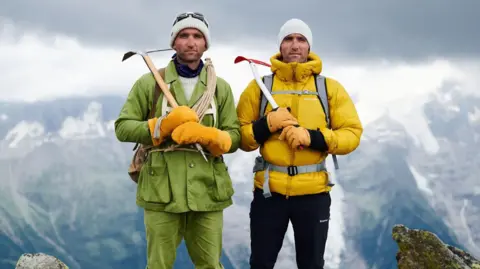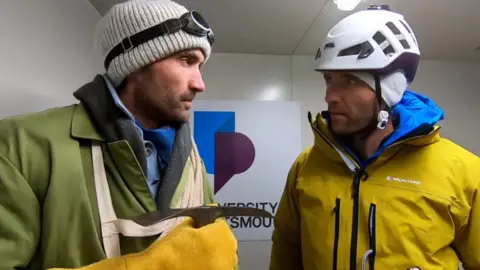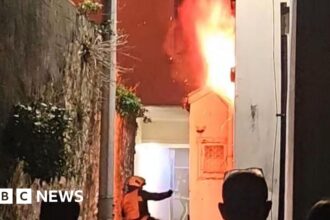 The Turner Twins
The Turner TwinsTwin brothers have conquered a Himalayan mountain, one dressed in modern clothing, the other wearing a replica of kit worn by British explorers 100 years ago.
Hugo and Ross Turner, from Christow in Devon, have taken part in a number of extreme adventures and said they wanted to see how their bodies reacted in the freezing temperatures of Mera Peak, near Everest, in Nepal.
Ross wore kit by the outdoor clothing brand Montane, whereas Hugo wore the same kit used by George Mallory and Andrew Comyn Sandy Irvine when they climbed Everest in 1924.
Hugo said the two-week expedition showed the vintage kit performed “very, very well”.
“Lots of people look at the old kit especially and there’s scepticism about how good it really was, with people throwing out their thoughts and ideas with no scientific basis,” Hugo told John Acres at Breakfast on John Acres at Breakfast on BBC Radio Devon.
“So, what we were setting out to do was really understand Mallory’s kit and what the data shows us, at a headline level, is that it was pretty good.”
He added: “Mallory’s kit was a couple of degrees colder than Ross’s kit on the summit phase of the climb; but it was a very, very good piece of kit.”
Allow Instagram content?
Mallory and Irvine died in their attempt to climb Mount Everest more than 100 years ago.
It is not known whether they reached the summit.
Edmund Hillary and Tenzing Norgay are credited with being the first to reach the summit in 1953.
The Turner Twins prepared for the freezing conditions by sitting in a cold chamber at the University of Portsmouth.
Ross said that, despite the work beforehand, it felt like the ascent did not get any easier.
“When the snow gets squeaky like polystyrene, it’s getting down to probably -20C [-4F] or below,” he said.

Ross added: “Everything seems perfectly normal, except your heart and your lungs are breathing very, very quickly and you’re walking at probably a step every two seconds.
“It’s really odd. And even though we were on the mountain for nearly a week, it didn’t really get any easier.
“So it was a, a game of patience. And, yeah, thankfully, as Hugh said, we summited, which was fantastic.”
When asked what the most dangerous part of the trek was, Hugh said it was when one of the photographers got altitude sickness.
“They had to go back down, so we thought one of the the support team will take them back down,” said Hugh.
“But we didn’t have enough in the team to take somebody else down.
“So he ended up leaving the camp at 8pm, in the dark, with a head torch and altitude sicknesses… [it] can be extremely quick and extremely dangerous.”
Hugh added: “It turned out he fell 50m around the glacier.
“Fortunately, he wasn’t injured and got himself back down to base camp. But it’s those tiny margins which can be dangerous.
“But, thankfully, he got down and lived to tell the tale.”







